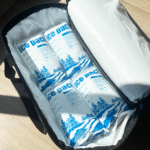In India, cold chain logistics plays a pivotal role in ensuring the safe transportation and storage of temperature-sensitive goods, such as food, pharmaceuticals, and biopharmaceuticals. As the nation grows into a global leader in both agricultural and pharmaceutical sectors, the demand for reliable cold chain systems has never been higher. This article explores the evolving landscape of cold chain logistics in India, focusing on key trends, challenges, and opportunities for 2025, while offering insights into how businesses can stay competitive and compliant in an increasingly complex environment.
-
What is cold chain logistics and why is it critical in India?
-
How does India ensure regulatory compliance in cold chain logistics?
-
What are the latest trends in cold chain logistics for 2025 in India?
-
Key challenges and opportunities for cold chain logistics in India
-
Technologies reshaping cold chain logistics in India
What is Cold Chain Logistics and Why Is It Important in India?
Cold chain logistics refers to the process of transporting and storing temperature-sensitive products at a regulated temperature to maintain their integrity and safety. In sectors such as pharmaceuticals, food, and biotechnology, this process is crucial to prevent spoilage, ensure product safety, and maintain efficacy.
In India, the need for efficient cold chain logistics is growing rapidly due to its vast agricultural sector, booming pharmaceutical exports, and increasing demand for temperature-sensitive products. Effective cold chain logistics ensures that goods are safely transported across vast distances while adhering to both domestic and international regulatory standards.
Key Benefits of Cold Chain Logistics in India:
-
Maintains Product Integrity: Cold chain logistics ensures that products such as vaccines, fresh produce, and medicines remain safe and effective.
-
Regulatory Compliance: Ensures compliance with national and international regulations, ensuring the safe transport of goods and product quality.
-
Economic Impact: Efficient systems reduce waste and spoilage, benefiting both businesses and consumers by maintaining product integrity and minimizing loss.
Why is Cold Chain Logistics Critical for India?
Food and Agriculture:
India is one of the largest global producers of fruits, vegetables, and dairy. Cold chain logistics is essential for preserving the quality of these perishable goods, both domestically and for export. Efficient cold chain systems ensure fresh produce, dairy, and meat products remain safe from farm to consumer.
Pharmaceutical Industry:
India is a key global player in the pharmaceutical sector, particularly for vaccines and generic drugs. Cold chain logistics is crucial for ensuring the efficacy of vaccines, biologics, and temperature-sensitive medicines. Proper transport and storage conditions maintain the integrity of these products, preventing spoilage or degradation.
How Does India Ensure Compliance in Cold Chain Logistics?
India’s cold chain logistics system is rigorously regulated to ensure the safety and efficacy of temperature-sensitive goods. The Food Safety and Standards Authority of India (FSSAI) and the Central Drugs Standard Control Organization (CDSCO) are responsible for enforcing standards for the transportation and storage of food, pharmaceuticals, and medical products.
Regulatory Compliance Framework:
-
FSSAI Standards: These guidelines ensure safe storage and transportation of perishable food products while meeting hygiene and temperature requirements.
-
Good Distribution Practices (GDP) for Pharmaceuticals: GDP regulations govern the storage and transportation of pharmaceutical goods, ensuring temperature control, secure transport, and documentation.
-
Global Compliance: India adheres to international cold chain standards, including the WHO’s Good Distribution Practices and the United States Pharmacopeia (USP), to ensure that goods meet global market access requirements.
Role of Technology in Enhancing Compliance:
-
Real-Time Monitoring: IoT-based temperature sensors provide real-time data, enabling businesses to monitor conditions and ensure compliance with industry standards.
-
Blockchain Technology: Blockchain offers enhanced traceability, securing data and ensuring that temperature-sensitive goods are transported under proper conditions throughout the supply chain.
Latest Trends in Cold Chain Logistics India for 2025
1. Digitalization and Automation
The adoption of digital tools and automation in India’s cold chain sector is rapidly transforming logistics operations. From automated warehouses to advanced temperature-controlled transport systems, these technologies are improving efficiency, reducing human error, and ensuring seamless operations.
-
Automated Warehousing: These systems ensure precise temperature control, optimized storage, and automated retrieval of goods, making warehouse operations more efficient.
-
Smart Logistics: AI and machine learning are used to predict demand, optimize delivery routes, and streamline logistics operations, reducing costs and improving efficiency.
2. Sustainability in Cold Chain Logistics
As environmental concerns grow, sustainability has become a key focus within cold chain logistics. Companies are investing in greener technologies to reduce their carbon footprint while maintaining operational efficiency.
-
Solar-Powered Cold Storage: These energy-efficient solutions are gaining popularity in rural areas, providing sustainable power for cold storage units and reducing operational costs.
-
Natural Refrigerants: The shift to natural refrigerants, which have a lower global warming potential, helps businesses reduce their environmental impact.
3. Advanced Tracking and Traceability Systems
Cold chain logistics in India is increasingly adopting advanced tracking systems such as GPS, RFID, and blockchain for better transparency, real-time monitoring, and compliance with temperature requirements.
4. E-Commerce and Last-Mile Delivery
As e-commerce continues to grow in India, there is a significant demand for efficient cold chain systems to support the last-mile delivery of temperature-sensitive products, such as groceries, medicines, and pharmaceutical items.
Key Challenges and Opportunities for Cold Chain Logistics in India
Challenges:
-
Infrastructure Limitations: While progress has been made, many regions in India still lack adequate cold storage and transport infrastructure, resulting in inefficiencies.
-
High Technology Costs: Advanced technologies like IoT sensors, automation, and real-time monitoring systems can be expensive, particularly for small and medium-sized enterprises.
-
Regulatory Complexity: Navigating the complex web of national and international regulations can be challenging, especially for smaller businesses.
Opportunities:
-
Government Support: The Indian government’s investment in cold chain infrastructure, such as the Pradhan Mantri Kisan Sampada Yojana (PMKSY), presents significant growth opportunities.
-
Private Sector Growth: As demand for high-quality, safe products increases, there are ample opportunities for private companies to invest in and expand cold chain networks.
-
Technological Advancements: The integration of IoT, AI, and blockchain presents significant opportunities to streamline operations, improve compliance, and reduce waste.
Technologies Transforming Cold Chain Logistics in India
1. Internet of Things (IoT)
IoT-based sensors play a crucial role in monitoring temperature and humidity during transit. These sensors help businesses track the conditions of goods in real time, reducing the risk of spoilage and ensuring compliance with required standards.
2. Blockchain Technology for Transparency
Blockchain ensures secure, immutable records of each transaction along the cold chain, improving traceability and accountability. This is especially crucial for ensuring that goods are transported according to temperature control regulations.
3. Artificial Intelligence (AI)
AI-powered solutions optimize cold chain logistics by predicting maintenance needs, optimizing delivery routes, and identifying potential disruptions in the supply chain. AI also helps businesses reduce operational costs by streamlining storage management and logistics.
FAQ: Frequently Asked Questions
How can I ensure my cold chain logistics in India comply with regulations?
To ensure compliance, use temperature sensors, real-time tracking systems, and maintain detailed documentation. Partnering with certified logistics providers can also help ensure adherence to regulatory standards.
What technologies can help optimize cold chain logistics?
Technologies like IoT for real-time monitoring, AI for route optimization, and blockchain for traceability are key innovations in optimizing cold chain logistics operations.
Conclusion and Recommendations
Cold chain logistics in India is poised for significant growth in 2025, driven by technological advancements, regulatory improvements, and the increasing demand for safe and high-quality products. To stay competitive, businesses should focus on investing in modern technologies, expanding infrastructure, and adopting sustainable practices.
Actionable Steps:
-
Invest in IoT and Blockchain Technology: Improve traceability and security by using real-time tracking systems and secure transaction records.
-
Enhance Cold Storage Infrastructure: Invest in both new cold storage facilities and energy-efficient solutions like solar-powered storage to improve accessibility and sustainability.
-
Adopt Sustainable Practices: Incorporate eco-friendly refrigeration systems and natural refrigerants to reduce environmental impact.
About Tempk
Tempk is a leading provider of cold chain logistics solutions in India, specializing in innovative technologies such as IoT, blockchain, and AI. Tempk helps businesses ensure the safe transport and storage of temperature-sensitive goods, improving efficiency and sustainability.
Contact Tempk to learn more about optimizing your cold chain logistics operations in India.
























